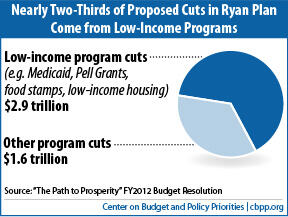- Home
- Chairman Ryan Gets Nearly Two-Thirds Of ...
Chairman Ryan Gets Nearly Two-Thirds of His Huge Budget Cuts From Programs for Lower-Income Americans
House Budget Committee Chairman Paul Ryan’s budget plan would get nearly two-thirds of its $4.5 trillion in budget cuts over 10 years from programs that serve people of limited means, which violates basic principles of fairness and stands a core principle of President Obama’s fiscal commission on its head.
The plan of Erskine Bowles and Alan Simpson, who co-chaired President Obama’s National Commission on Fiscal Responsibility and Reform, established, as a basic principle, that deficit reduction should not increase poverty or inequality or hurt the disadvantaged. The Ryan plan, which the chairman unveiled in a news conference, speech, and Wall Street Journal op-ed, charts a different course, turning its biggest cannons on these people.
This finding emerges from a Center on Budget and Policy Priorities analysis of the Ryan plan. Table S-4 of the plan, as Chairman Ryan unveiled it on April 5, showed that the plan contains net program cuts of $4.3 trillion over ten years. [1] The table showed a $5.8 trillion cut in outlays from the Congressional Budget Office baseline — but $446 billion of that was interest savings and another $1.04 trillion was simply an assumption that the Iraq and Afghanistan wars will phase down on the Obama Administration’s timetable. Actual program cuts produced net savings of $4.3 trillion.
The following week, when the budget plan went to the House floor, Chairman Ryan added $197 billion in cuts in order to offset an overestimate of interest savings.[2] This brings the total program cuts in the plan to $4.5 trillion.
Cuts in low-income programs appear likely to account for at least $2.9 trillion — or nearly two-thirds — of this total amount. The $2.9 trillion includes the following three categories of cuts:
- $2.17 trillion in reductions from Medicaid and related health care. The plan shows Medicaid cuts of $771 billion, plus savings of $1.4 trillion from repealing the health reform law’s Medicaid expansion and its subsidies to help low- and moderate-income people purchase health insurance.
- $350 billion in cuts in mandatory programs serving low-income Americans (other than Medicaid). Chairman Ryan’s budget documents show that he is proposing $719 billion in cuts in mandatory programs other than Medicare, Medicaid, and Social Security, but do not specify how much will be cut from various programs (although they imply that cuts in the Food Stamp Program will be large). In this analysis, we make the conservative assumption that savings from low-income mandatory programs (other than Medicaid) would be proportionate to their share of spending in this category. Thus, we derive the $350 billion figure from the fact that about half of mandatory spending other than for Medicare, Medicaid, and Social Security goes for programs for low- and moderate-income individuals and families. This likely substantially understates the cuts that the plan would make in low-income programs. The Ryan documents show that $380 billion in cuts would come from mandatory programs in the income security portion of the budget (function 600), and the overwhelming bulk of the mandatory spending in that category goes for low-income programs. The documents also show $126 billion in mandatory cuts in the education, training, employment, and social services portion of the budget (function 500), which, based on the discussion in those documents, would likely come mainly from cuts in the mandatory portion of the Pell Grant program for low-income students.Image

- $400 billion in cuts in low-income discretionary programs. The Ryan budget documents released on April 5 showed the plan containing $1.6 trillion in cuts in non-security discretionary programs, but again did not provide details about the size of cuts to specific programs. (The documents did identify some major low-income program areas, including Pell Grants and low-income housing, as prime targets for cuts.) Here, too, we make the conservative assumption that low-income programs in this category would bear a proportionate share of the cuts. Thus, we derive the $400 billion figure from the fact that about a quarter of non-security discretionary spending goes for programs for low- and moderate-income individuals and families. (Rep. Ryan added $193 billion in cuts in non-security discretionary programs before the budget resolution went to the House floor, but Ryan said these additional cuts would come from freezing federal employees’ pay and reducing the federal workforce, so we do not include them when estimating reductions in programs for low- and moderate-income households.)
Our numerical assumptions are conservative in another way, as well. When faced with the choice of which specific programs to cut, policymakers are unlikely to cut much from a number of non-low-income programs in these budget categories that are popular, such as veterans’ disability compensation and the FBI. That means that other programs — including low-income programs — would have to be cut by more than their proportionate share.
End Notes
[1] House Committee on the Budget, “The Path to Prosperity: Restoring America’s Promise,” April 2011, budget.gop.gov.
[2] Kathy Ruffing, “House Budget Committee: Mistakes Were Made,” OfftheCharts blog, April 13, 2011, http://www.offthechartsblog.org/house-budget-committee-mistakes-were-made ; House Committee on the Budget, Revised Summary Tables, updated April 11, 2011, http://budget.house.gov/UploadedFiles/SummaryTables.pdf.
